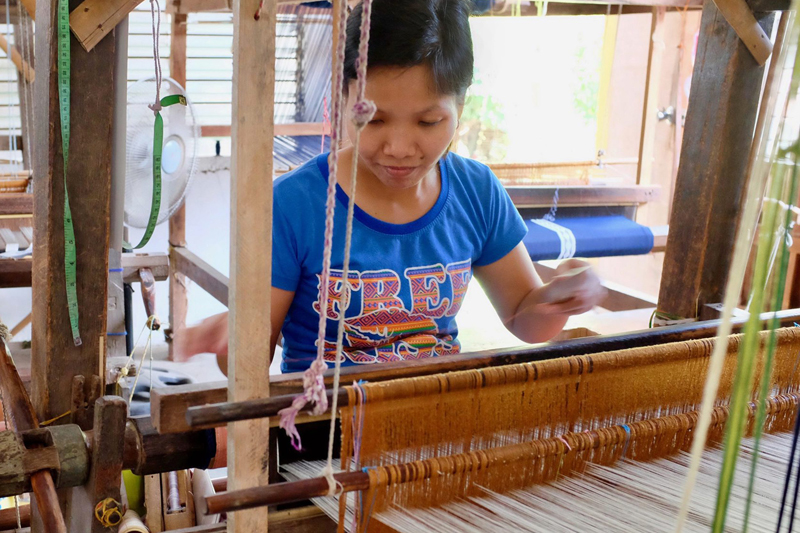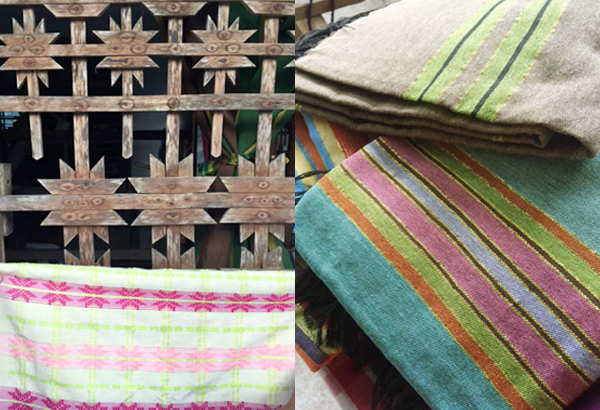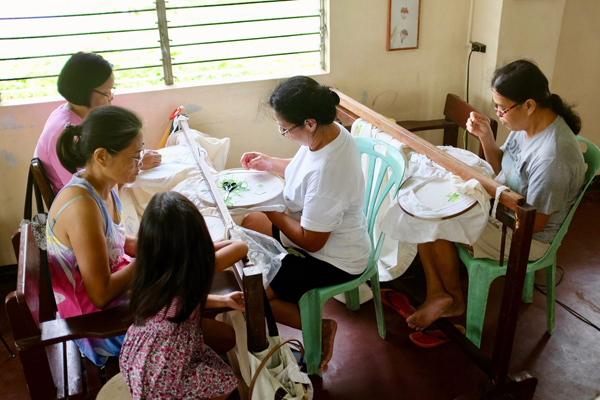For Iloilo’s Textiles: Innovation is Preservation

A weaver meticulously works on her textile using a hand loom.
MANILA, Philippines — On a relatively cool morning in February, we arrived straight from the airport at a weaving center in Badiangan, a town just outside Iloilo City. We were met by Elda Baldon, head of the Cabayogan Women’s Loomweavers Association. She was excited to show us the orders they finished from our last trip in November. With pride, she also showed us a special fabric that she made herself – a striped diamond pattern (Mata Mata) Dobby weave – remarkably, on a regular hand loom. Our resident textile expert, Candy Costa, was just as impressed as I was. Innovating these fabrics was not going to be as hard as we thought.
In 2018, we hit the ground running to bring one of our oldest surviving crafts to the 21st century and give it a rightful place in our modern world. With the combined efforts of the ECHOsi Foundation and the Gender Responsive Actions for the Transformation of Women (GREAT Women) Program 2 – the partnership we have with the governments of Canada and the Philippines through the Philippine Commission on Women – we will bring sound business practices and technological innovations to adorable Ilonggos who weave art as part of their daily lives.

The talented women are capable of creating several different traditional and modern patterns.
In the 1800’s, Iloilo was known as the textile capital of the Philippines. There were as many as 4,000 looms in the town of Miag-ao alone. That was plenty for a province barely reaching 50,000 residents. It was part of everyday life, where hand weaving was done at home and the skills were passed on from mothers to daughters. Textiles were also Iloilo’s top export, which made it as much a part of their economy as their culture.
Today, there are less than 500 looms across a province that is home to nearly 2 million. Something broke down along the way, and most Ilonggos won’t hesitate to say why. The fabrics have been frozen in time, with the colors and designs deemed appropriate only for cultural galas and town fiestas. The supply chain is also broken, as the weavers are at the mercy of the few polyester yarns they can get their hands on. Cotton is nearly impossible to get, as are the many traditional yarns made of pineapple and banana. What used to be a luxurious fabric is now uncomfortable and unfashionable to most of the people I spoke to.

Among the designs they weave are star-like shapes inspired by the window patterns, made by the Indag-an weaing community from Miag-ao and traditional striped weaves of Iloilo.
After half hour on the road, we reached the town of Santa Barbara, close to the airport and home to the oldest golf course in the country. It’s also home to possibly the only Belgian-style lace makers in the country. It was our second trip to WUTHLE, which stands for Women United Through Handcrafted Lace and Embroidery. We watched in awe again as these skilled women made their usual clacking noises while expertly braiding threads with bobbins. The process is very slow, perhaps producing two inches of lace a day. It also takes a huge toll on eyesight, which is why these women prefer to work by the windows, using natural light. This exceptional art was only born 30 years ago but is already in danger of extinction. There are only 30 of these women left, and they’re all over 60. There are even less of the hand embroiderers left – only eight.
Early again the next morning, we headed straight to Miag-ao, which is an hour away from Iloilo City. Miag-ao weavers can do very complicated patterns on fabrics by hand, and we checked how the orders from our last trip came out. As part of teaching sound business practices, we helped them name their own designs, to make order-taking more systematic. We suggested Hiligaynon words like Tun-og (sunset), Bai-Bai (women) and Balud (wave) which pay due respect to the language and culture of the weavers.

After an hour on the road, surrounded by seemingly endless road expansion and bridge construction, we reached a weaving center in the town of Oton. We met again with the energetic young women we saw on our last trip. Their excitement showed in their hospitality. Waiting for us were freshly boiled bananas and coffee. Since our test orders came out beautifully, Candy felt it was time to move them to more complicated weaving techniques. This was to be their next step in differentiating our traditional weaves from commercially available fabrics.
The ultimate goal of our Design Lab is to bridge our ancient crafts and our modern way of living. Handwoven fabrics, designed correctly, managed professionally and marketed with a realistic plan can legitimately grow beyond livelihood into a real industry. Iloilo, where 96 percent of the population live outside the urban areas, can achieve the elusive Triple Bottom Line of social, ecological and financial success. Instead of leaving the farmlands to become domestic helpers in the cities or abroad, these skilled women can work while their children are nearby. Farmlands can become part of the supply chain and generate more jobs. And when the real value of these handcrafted fabrics becomes part of everyone’s culture, living wages won’t be a distant dream.
I showed the newest kind of fabric that we just ordered to Japh Padasas, our 23-year-old guide who works at the Provincial Capitol. “Wow! he said. “I’d wear that.”
* * *
The author is chief design director, ECHOsi Foundation Design Lab

- Latest
- Trending


















